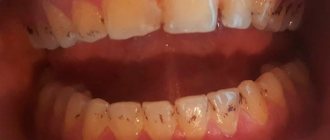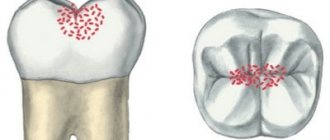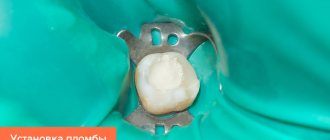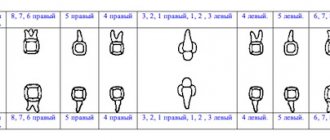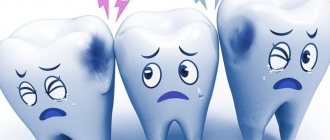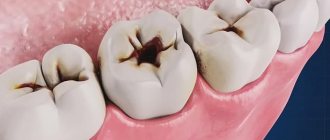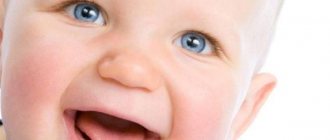Treatment of dental pathologies in children is a complex process that requires extensive practical experience and knowledge of child psychology. Especially when it comes to baby teeth. In order not to damage the rudiments of permanent units, the doctor must perfectly know the technique of performing manipulations and act very carefully.
Children's doctors at the Levoberezhnaya Dental Clinic try to save teeth even with extensive damage and remove them only as a last resort. You can make an appointment by calling the phone number listed on the website or using the online form.
Treatment of caries of children's primary teeth
Caries of primary chewing and front teeth has long been treated without the slightest pain.
New modern techniques have reduced the use of drills and drilling to a minimum, and timely scheduled examinations make it possible to detect the disease at a very early stage. The doctors at Aza&Buka Pediatric Dentistry who work with young patients are distinguished by an amazing sense of tact and constant positivity. Knowledge of the child’s psychology allows doctors to build communication and dialogue in such a way that children sit in the dental chair without the slightest fear. If the child already has some dental phobia, then adaptation techniques can solve the problem.
Caries on baby teeth in children is treated using the following technologies:
Why do babies get caries?
Yes, caries in children under 3 years of age still surprises parents. "How so? After all, the baby doesn’t even know cigarettes and soda yet?” - they shrug their shoulders. In fact, there are two main groups of reasons for the appearance of caries in babies: poor lifestyle during pregnancy and insufficient oral care for the child after birth. Let's look at each group separately.
Pregnancy
The expectant mother should be especially attentive to herself. The baby's teeth begin to develop around the 12th week of pregnancy. It is important for a woman to understand that the process of feeding a child is a process that begins with conception.
For the health of the baby’s teeth, hair, nails, skin and other organs, the expectant mother should choose natural products that contain the daily requirements of essential vitamins and minerals:
- Dairy
. First of all, the expectant mother should choose cottage cheese, natural yogurt and hard cheeses. These treats contain calcium, protein, vitamins B, D, and Omega-3 polyunsaturated fats that baby’s teeth need.
- Nuts
- This is a storehouse of vitamins and nutrients necessary for the formation of teeth in a baby. Nuts contain selenium, magnesium, vitamin E, phytic acids and Omega-3 polyunsaturated fatty acids.
- Fish and seafood
. Everyone knows that fish contains the phosphorus needed by bones and teeth and beneficial vitamin D, which strengthens the nervous system of a pregnant woman and baby.
- Meat, liver
. Important cell building materials are meat and liver. These products contain the protein necessary for a growing body. The liver is rich in iron and B vitamins.
- Chicken and quail eggs
. These products contain more than 10 useful vitamins and microelements that affect the growth and abilities of the baby.
- Vegetables
. Vitamins, fiber, microelements and organic acids necessary for the development of healthy baby teeth are found in abundance in vegetables. Avocados, broccoli and carrots are especially useful for the expectant mother. These vegetables (in any form - raw or cooked) contain the most calcium, vitamins B, C and folic acid.
- Berries and fruits
– vitamin support for pregnant women and the key to the normal development of the child.
- Legumes
contain iron, folic acid and vitamin B-6, necessary for mother and baby.
- Cereals
rich in B vitamins, fiber and iron. Milk porridge will be very useful.
- Spinach.
The plant contains a lot of folic acid, calcium and vitamin A. In addition, the leaves are not at all difficult to grow at home on the balcony, and then enjoy them in the form of soups, purees and side dishes.
And, of course, the expectant mother should avoid taking antibiotics: such drugs can destroy the child’s health.
Classic filling
requires a special approach when treating young patients, since the doctor has to use dental equipment, which often causes fear in children.
Aza&Buka dentistry uses both traditional and modern methods of treating caries of primary teeth, selecting a method taking into account the age of the child and the degree of neglect of the process.
Plaksina Margarita
“Modern parents are great! They themselves are not afraid of dentists, and children are taught the same thing: to come on time for preventive appointments and examinations. In such cases, doctors can intercept the very beginning of a cavity infection and prevent tooth decay without drilling.”
Where can you get your child’s teeth treated without fear?
It is good if the child is observed by one dentist throughout the entire period from early childhood to 18 years.
Firstly, the baby will always see a familiar doctor in front of him and will not be afraid, cry or worry. And secondly, a specialist who monitors the child’s dental health from an early age knows all its features and will notice the problem at the very beginning of its development. It is important not only how teeth are treated for children 2 years of age and older, but also where it is done. All establishments in the city are divided into three large groups:
- State clinics. This option is best left for last resort. Why? There are long queues, many capricious children, nervous parents and doctors who are given a limited time for an appointment and not a minute more. At the same time, dental equipment, as a rule, remains from the last century, and no one has heard of good medicines and fillings.
- Special children's rooms in high-profile private hospitals. If you are looking for a good combination of price and quality, then this option is suitable. There is all the necessary equipment, modern medications designed specifically for baby teeth, and a specialist doctor whose competence includes only the treatment of children’s first teeth will work with a boy or girl.
- Private specialized children's dental clinics. They are intended exclusively for small patients. Here everything is done for their coziness and comfort, there are no long queues, all patients come only at the appointed time, and you can make an appointment for a convenient day for an appointment. All equipment, instruments and medications are intended exclusively for children's teeth. Well, the quality of service always remains at the highest level. The only negative is the high prices, and even a simple consultation will be paid.
Which treatment methods to choose and where exactly the baby should be treated is, of course, decided by the parents. You should not go to extremes and should choose according to your financial capabilities. After all, even in a free city clinic you can get access to competent and experienced specialists. The only thing that remains is to read the reviews and ask your friends who and how they treat the teeth of children aged 4 years. If possible, immediately contact a paid pediatric dentistry.
Milk caries: initial, superficial, medium, deep
Doctors distinguish 4 stages of the formation of carious areas:
- Initial caries - tooth enamel becomes covered with small spots of white or yellowish tint.
- Superficial caries - the enamel begins to deteriorate, small and light cavities are observed.
- Medium – the layer of tooth enamel is destroyed, the affected area extends deeper.
- Deep - the layers of dentin have already been affected, and the pulp is under threat.
It is necessary to treat milk caries at the very first stage, although it does not cause any discomfort in the child. The fact is that the enamel and crowns of temporary teeth are subject to rapid destruction, and the development of caries occurs very quickly. Deep caries often provokes irreversible changes, which leads to premature removal of the baby tooth.
Rodikova Tatyana
“Medium and deep caries most often occurs in schoolchildren, almost teenagers. Children brush their teeth poorly, and they talk about problems only when caries has already affected the pulp. In this case, the treatment turns out to be more unpleasant, since removal of the pulp cannot be avoided. That’s why I always ask parents to carefully monitor their teenagers’ hygiene and bring them to appointments on time.”
Oral care
Caries in children aged 2-3 years can also develop due to the inattentive attitude of parents. Let's look at the main mistakes that moms and dads make:
- Pacifiers and bottles in a dream.
To teach a child to sleep alone, parents give him a pacifier or even a bottle of milk at night. As a result, the child enjoys the sweet taste of the drink all night, and the teeth are slowly but surely destroyed. Such a habit, of course, will give mom and dad healthy sleep, but in the baby it can lead to bottle caries and malocclusion.
- Sweet life.
Of course, most kids are unfamiliar with the problem of excess weight. Therefore, grandparents strive to treat the child with additional cake or candy. And, as you know, bacteria on enamel love sugar with a tender love, and very soon children under 3 years old develop caries, which requires treatment.
- Insufficient dental care
. Many parents believe that there is no need to care for baby teeth at 2-3 years of age. As a result, plaque accumulates, and carious monsters spread over both grown and still growing teeth.
Symptoms of caries in babies
It can be difficult for parents to notice that their child’s teeth are affected by caries. Dentists distinguish several stages of the development of the disease:
- Initial.
Subtle white spots appear on the baby's teeth. These spots can be large or very small, round or rectangular. The child does not experience any unpleasant sensations at the initial stage. Therefore, parents who do not examine their children's teeth skip this stage, and the enamel continues to deteriorate.
- Superficial
. At this stage of caries, teeth change more noticeably: dark spots appear on the top layer of enamel. Some children complain of pain when eating irritating foods (sour, salty and sweet). The enamel is damaged, the tooth cavity opens to bacteria.
- Average
. Caries bacteria reach the dentin (the tissue located inside the tooth). The baby complains of pain when eating foods that are too cold or too hot.
- Deep.
In children, deep caries is much more difficult than in adults. Most of the internal tissue of the tooth is damaged, and pulpitis develops sharply.
Unfortunately, in children under 3 years of age, unlike adults, caries often affects all teeth at once. Several holes may appear on one crown from different sides at once. Therefore, parents need to be extremely attentive to their children and devote time to oral care even before the first tooth appears.
Reasons for the development of caries in temporary teeth
When visiting a dentist, parents are invariably interested in the reasons for the appearance of such an unpleasant disease. This is important because it helps prevent damage to new teeth. Sometimes it is enough to change eating habits and hygiene patterns so that the child forgets about fillings for a long time, and only comes to the dentist for examinations.
Causes of caries:
- Poor or insufficient oral hygiene. Food remains in the interdental space and on the enamel are an excellent environment for the development of carious bacteria.
- An unbalanced diet with a preponderance of sweets and carbohydrates - during the fermentation of simple carbohydrates, acids are formed that provoke the destruction of enamel.
- The lack of solid foods in the menu leads to a decrease in the frequency of chewing, reduces salivation and becomes a common cause of caries of primary teeth in young children.
- Long-term use of nipples, including on bottles and sippy cups, increases the risk of developing single or multiple bottle caries of the anterior milk teeth in children.
- Rickets is a pathology that provokes the destruction of dental tissues.
- Genetic predisposition of the child.
- Problems with bite – various anomalies in the formation of the dentition.
- Decreased natural immunity due to frequent acute respiratory viral infections, chronic diseases, and taking various medications.
- Damage to tooth germs in the prenatal period - due to maternal illness or neglect of health in the first trimester.
At what age can you treat
There are no strict age limits regarding the age at which children can have their teeth treated. Indications for visiting a doctor are:
- carious foci of infection in the oral cavity;
- inflammation of periodontal tissues;
- baby has bad breath;
- enamel fluorosis.
What happens if dental problems are not treated? A chronic source of infection can lead to premature tooth loss and other health problems - pharyngitis, laryngitis, disruption of the functioning of the intestines and stomach. Children with untreated caries become vulnerable to viral, fungal and bacterial pathogens due to the fact that their immunity cannot work at full strength.
Caries can spread not only to enamel and dentin, but also to the rudiments of permanent elements, provoking the development of periodontitis. One of the serious complications of dental disease is pulpitis, accompanied by acute pain.
Pulpitis has several stages of progression, and the most complex of them lead to complete destruction of the tooth and involvement of the neurovascular bundle of the unit in the pathological process. An infection through the bloodstream can spread throughout the body and cause a malfunction of the respiratory system and heart.
Untimely loss of dentition elements leads to improper chewing of food due to unevenly distributed load between different parts of the jaw. Insufficiently processed and crushed food is poorly absorbed by the gastrointestinal tract. Therefore, children should be shown to dentists at the moment when they show the first signs of dental disease, regardless of age.
Endolaryngeal infusions
Recommended for acute laryngitis, along with nebulizers, mucolytics and much more.
The cause of acute laryngitis in most cases is a viral infection. Therefore, the main treatment here is time. The use of antibiotics is not indicated even for mild bacterial infections in the larynx, which are much less common than viral ones.
With endolaryngeal infusion, the solution enters directly onto the vocal folds at the time of phonation, which means there is a very high risk of it entering the lower respiratory tract. In cases where the larynx is poorly visible and the procedure technique is not followed, the doctor pours the solution into the esophagus, the patient swallows it, and there is no positive effect after the procedure, even temporary. At the same time, such a “blind” infusion of the solution increases the risk of aspiration (entry into the respiratory tract).
Antibiotics are used for infusions into the larynx, which, when applied topically, do not have a bactericidal effect. Oil solutions can be used, the positive effect of which is easily replaced by a home humidifier and ventilation. The effect of using hormonal agents (dexamethasone or hydrocortisone) is very short-lived. Moreover, in emergency situations, for example, for singers before a concert, preference should be given to the systemic use of hormonal therapy. The use of hormones leads to the rapid disappearance of inflammation of the vocal folds and improvement of voice quality, but one has to put up with the possible side effects of this group of drugs, so in standard situations the potential risk of their use outweighs the possible benefits.
A number of studies have shown that the voice is restored in equal time - when treated with antibiotics and when taking a placebo.
Important to know : viral laryngitis usually lasts 7-10 days and goes away on its own.
Reverse overlap of incisors
Reverse incisor overlap is when the lower teeth protrude forward). Reverse overlap blocks the normal growth of the upper jaw in length. The most optimal time to correct such a bite is from the age of 5-6 years. At this age, the incisors of the upper and lower jaws erupt and this is the most favorable time to begin orthodontic correction. If you notice a reverse overlap in a child at a later age, it is also important to contact an orthodontist in order to rid the upper jaw of the blockage as quickly as possible and give it the opportunity to continue to grow actively.
Differences between sedation and general anesthesia
1) The occurrence of coughing, swallowing and other reflexes is excluded, which in turn allows for complete dental safety.
2) The dentist can fully control the patient’s condition, since he is conscious throughout the entire procedure. Another advantage of the action of sedatives is the fact that a person under its influence can be taken out of a state of superficial sleep at any time.
3) The patient is in a relaxed state and can communicate with the doctor.
Very often, due to anxiety, a person cannot clearly formulate his problem, and the patient’s internal tension can complicate treatment. Sedation makes it possible to relieve emotional stress without causing harm to the body. Also, when a person experiences psychological stress, hemodynamic changes occur. High blood pressure and rapid heartbeat force the attending physician to make certain changes to the given treatment regimen.
What is rehabilitation like after treatment under anesthesia?
After waking up from anesthesia, in the vast majority of cases, children feel well. Most often, the only thing that bothers them is numbness in the areas where the local anesthetic was injected.
As for behavioral changes, there are three types:
- excitement - the baby may be capricious and cry. This is accompanied by increased activity. But it quickly gives way to fatigue;
- fatigue - the child wants to sleep, refuses to eat, sits in the arms of the parents;
- no behavioral changes after waking up.
The first two scenarios are typical for children under the age of 7-10 years, the third - for adolescents and adults.
Hyperactivity and agitation upon awakening are unpleasant for both the child and those around him. To avoid it, we try to implement the second scenario; to do this, we put the baby to sleep and wake him up gently.
The child can eat immediately after waking up, unless the anesthesiologist gives other recommendations.
Very rarely, recovery from anesthesia is accompanied by nausea or a feeling of motion sickness. This lasts no longer than 2-3 hours. This reaction is typical for children who get motion sickness in transport. In this case, you will be able to eat and drink within an hour or after the nausea has passed.
There is no need to worry about the postoperative period - the anesthesiologist will always be in touch.
Impaired pronunciation of certain sounds
If a child stubbornly refuses to make certain sounds, despite all the efforts made by the speech therapist, it makes sense to visit an orthodontist. It is advisable to do this after 5 years. The cause of the violations may be anatomical features or malocclusion. A short frenulum of the tongue, for example, can lead to impaired pronunciation of sounds. Open bite and “reverse” bite also lead to speech distortion. The orthodontist will assess the degree of malocclusion or the anatomy of the tongue frenulum, give recommendations or prescribe treatment.
Asymmetry in the face, smile, bite
If you notice any signs of asymmetry in a child, this is a reason to immediately consult a doctor. At any age of the child - as soon as noticed. Of course, all people are naturally asymmetrical. But natural asymmetry is not visible to the eye and does not attract attention. What you need to pay attention to in terms of asymmetry: • displacement of the chin to the side • the smile is not symmetrical • the central lines of the upper and lower jaws do not coincide (with each other and with the central line of the face). The orthodontist will be able to conduct an examination and prescribe the necessary treatment or examination to identify the causes of asymmetry.
How is caries of permanent teeth treated in children?
Caries on permanent teeth is treated as in adults. The main method is filling. Photocomposites are the most successful for sealing the affected cavity. These are materials that do not differ in color or texture from teeth. Filling takes place in several stages:
- Introduction of anesthesia.
- Removing dead tissue using a drill and cleaning the cavity.
- Rinsing the tooth with an antiseptic.
- Air drying.
- Application of phosphate cement insulating gasket.
- Filling with composite materials in several layers, each of which must be dried with a special lamp.
For shallow caries, infiltration, remineralization or ozone therapy can be used. Silver plating is contraindicated.
How to choose a doctor for your child
A child's first visit to the dentist is a very important event that should be taken very seriously. It is imperative to find a doctor who gets along well with children and to whom the child will go with great pleasure. This will determine whether he will have a fear of dentists in the future.
It is recommended that you spare no expense for the first time and take your child to a paid clinic . In such institutions, treatment is accompanied by a friendly attitude from the staff; children are often shown cartoons and given toys to play with.
Peculiarities
Babies' first teeth appear at one year of age. By the age of three, they have grown a full set of them.
They have their own characteristics:
- thin enamel layer;
- loose structure of dental and gum tissue;
- undeveloped local immunity;
- high degree of tissue vascularization.
For these reasons, children's teeth and gums are more susceptible to the pathological effects of bacteria. Inflammatory processes occur faster in them, infection spreads faster, and complications occur more often.
How is dental treatment performed for children under sedation?
Specific preparation measures are selected depending on the type of sedation, but the preparatory stage cannot be avoided. This is especially true for deep sedation, when it is necessary to take blood tests and determine possible allergic reactions to drugs. Before the procedure, you need to completely give up smoking and alcohol (although this requirement is not so important for a child), and also not eat food 8-10 hours before treatment. During inhalation sedation using nitrous oxide, a light breakfast is possible. After all the necessary preparatory measures have been taken, the entire treatment process is divided into four stages:
- final examination of the oral cavity;
- introduction of a sedative into the body;
- anesthesia;
- treatment.
Treatment of baby teeth and tooth extraction usually does not take much time. The more extensive the treatment, the longer the sedation should last. In some cases, treatment is divided into two stages.
Superficial sedation does not require additional measures to emerge from drug-induced sleep. Deep sedation often involves the use of special antidotes.
Types of sedation in pediatric dentistry
Sedation for children has a number of features, since not all methods and drugs are suitable for the child’s body.
- Inhalation method (nitrous oxide).
Nitrous oxide sedation is a very common technique in pediatric dentistry. There are several reasons for this. First, nitrous oxide is safe and can be used even on children under 5 years of age. Secondly, dental treatment with gas for children does not require a special license for the use of psychotropic substances. Nitrogen has a minimal effect on the body's systems, and the child recovers very quickly after the procedure. On the other hand, expert reviews of this method are mixed. Many people consider nitrous oxide not the best means for sedation, and sometimes individual intolerance occurs. Dental treatment for children with nitrous oxide cannot last long: the duration of action of laughing gas is very limited. - Oral method.
The effect of sedation is achieved by oral administration of drugs from the benzodiazepine group (Valium, diazepam and similar drugs). This type of sedation is not recommended for children under 5 years of age, and the dosage must be calculated very accurately. - Intravenous method.
The most powerful type of sedation that causes significant depression of consciousness. The drugs are given through a vein, and the patient may require an oxygen mask to maintain breathing. This type of sedation is not given to children.
Experts' opinion
The complex composition of ASEPTA Baby toothpaste allows you to simultaneously care for your gums and teeth. The product has:
- Certificate of state registration;
- Certificate of conformity No. ROSS RU. AG81.H01070.
The paste does not contain fluoride and does not require consultation with a doctor before use. The product is safe if swallowed, as it does not contain components harmful to the health of the baby.
Sources:
- Report on determining/confirming the preventive properties of toothpaste “ASEPTA PLUS” GENTLE WHITENING” Author: doctor-researcher A.A. Leontyev, head Department of Preventive Dentistry, Doctor of Medical Sciences, Professor S.B. Ulitovsky First St. Petersburg State Medical University named after. acad. I.P. Pavlova, Department of Preventive Dentistry
- Report on the determination/confirmation of the preventive properties of personal oral hygiene products “ASEPTA PLUS” Remineralization doctor-researcher A.A. Leontyev, head Department of Preventive Dentistry, Doctor of Medical Sciences, Professor S.B. Ulitovsky First St. Petersburg State Medical University named after. acad. I.P. Pavlova, Department of Preventive Dentistry
- Clinical experience in using the Asepta series of products Fuchs Elena Ivanovna Assistant of the Department of Therapeutic and Pediatric Dentistry State Budgetary Educational Institution of Higher Professional Education Ryazan State Medical University named after Academician I.P. Pavlova of the Ministry of Health and Social Development of the Russian Federation (GBOU VPO RyazSMU Ministry of Health and Social Development of Russia)
Mouth breathing
If you find that your child predominantly breathes through his mouth or snores at night, I advise you to immediately contact an ENT doctor first and foremost. Orthodontic measures for oral breathing in children can begin at 3-4 years of age. Mouth breathing in children leads to a violation of the position of the tongue: the tongue moves down the oral cavity and ceases to occupy the desired position. So it does not have a stimulating effect on the upper jaw - and it does not develop to the required extent. As a result, there is not enough space for permanent teeth, and they begin to grow unevenly. In addition, a narrow upper jaw can cause a habitual lateral displacement of the lower jaw. A crossbite and facial asymmetry will form. When dealing with mouth breathing, it is important to work in conjunction with an ENT doctor and often with a speech therapist. In some cases (for example, if the cause of mouth breathing is allergic rhinitis), we also involve an allergist. The task of the ENT doctor is to normalize the patency of the airways so that the child can physically breathe through the nose. Next, the orthodontist and speech therapist are included in the work. A speech therapist works with the muscles of the lips and tongue to train them and teach them to work normally. The orthodontist eliminates the effects of mouth breathing and can also prescribe myogymnastics - training for the muscles of the lips, cheeks, and tongue.
Sedation scheme
The patient puts on a mask, and 100% oxygen first enters his lungs. The oxygen mass is supplied at a speed of 4-6 liters per minute. Nitrogen is gradually mixed with oxygen. Its content is increased to 30%. When the proportions of nitrogen and oxygen are brought to a ratio of 30 to 70, respectively, the moment comes favorable for starting treatment. However, it should be noted that the concentration of nitrous oxide may vary depending on the individual patient. It is important to achieve the desired effect, and it, in turn, can occur with a different ratio of nitrogen and oxygen. Individual indicators are recorded in the patient's record.
The blood is saturated with gas in about 5-7 minutes. Nitrous oxide is completely dissolved in blood serum and is not biotransformed in any way. As soon as the supply of ZAX stops, the process of removing gas from the lungs begins. The gas is removed completely unchanged.
ZAX differs from other sedatives in that the sedative effect occurs very quickly, and the trace effect is completely absent. This is caused by nonspecific depression of the central nervous system.
Sedation manifests itself as follows: a comfortable and relaxed state; good, elevated mood; movements are inhibited; deep breathing; motor activity of the eyes is reduced; sound perception is dull; resistance is reduced.
If you plan to undergo a particularly painful procedure, you can temporarily increase the concentration of nitrous oxide to 50% (acceptable limit is 70%). Nitrous oxide has an analgesic effect, and also enhances the effect of local anesthetics. If the child is suddenly frightened and painful sensations begin to “reach” him, manipulation with nitrous oxide will quickly calm the baby down and treatment can be continued.
Thus, the use of ZAX makes it possible to carry out treatment of any complexity in just one visit.
As for removing the patient from the state of sedation, it occurs smoothly and consists of supplying 100% oxygen for 5-10 minutes. At this time, the doctor communicates with the child, trying to reinforce his positive impressions of visiting the dental office.
In general, the successful use of ZAX is impossible without the competent use of behavior management techniques. Trying on a mask by a child should be done in a playful way so that the child has time to relax before the onset of sedation. The doctor calms the child by telling him about the condition he will soon find himself in. You cannot force a mask on, as this may cast doubt on the success of the procedure.
Puncture of the maxillary sinus
Practically not used in modern otorhinolaryngology. For acute bacterial sinusitis, systemic broad-spectrum antibacterial drugs are indicated, which successfully cope with the bacterial process without punctures and “cuckoos”.
Punctures for a bacterial process in the maxillary sinuses are mainly indicated if culture of the sinus contents is needed - usually when 1-2 courses of antibacterial therapy are ineffective.
Very rarely, such punctures are performed for diagnostic purposes, when it is not possible to perform radiography or computed tomography of the paranasal sinuses. Another indication is severe pain associated with the pressure of the contents on the walls of the sinus. The puncture is done once during the main treatment. Several punctures are indicated only in the case of a persistent bacterial process with two or more courses of antibiotics, and there is no possibility of performing endoscopic surgery on the sinuses.
It has been proven that puncture of the maxillary sinus does not speed up the healing process.
It is important to know : puncture, like any invasive method, can have complications, including trauma to the medial wall of the orbit, nasolacrimal duct, soft tissues of the cheek, and nosebleeds.
